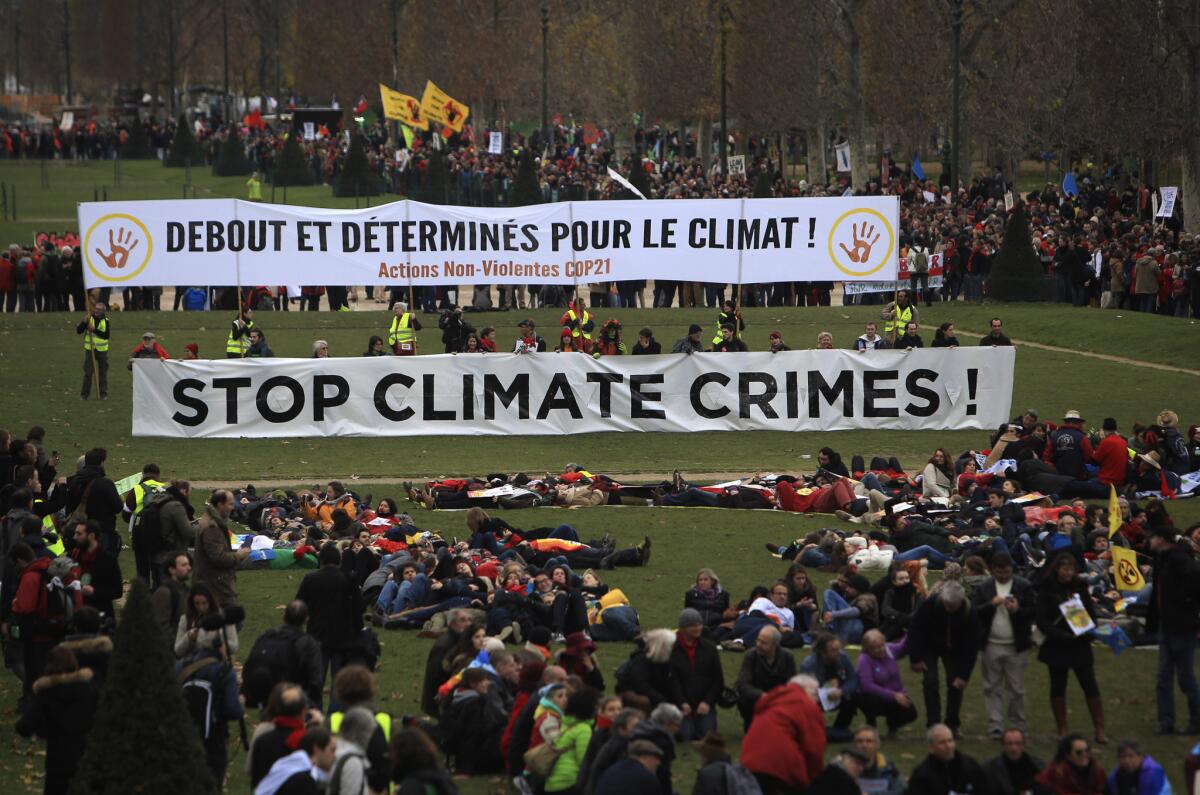Climate change activists are just warming up

Activists gather during a demonstration in Paris
- Share via
Reporting from SEATTLE — Even as it became clear that a historic climate agreement could be reached in France, activists were organizing protests deep into next year, some liberal political leaders were pledging to go beyond whatever goals the agreement might yield and diplomats, scientists and consultants were planning the next global summit.
In the final days of COP21, as the 21st Conference of Parties came to be called, a hashtag briefly came to life on Twitter: #COP22.
That would be the 22nd Conference of Parties, scheduled for next November in Morocco.
On the day of the Paris agreement, Hakima El Haite, the Moroccan environmental minister, reached out to Christiana Figueres, the head of the United Nations Framework Convention on Climate Change: “Thank you, dear Christiana, for your dedication,” El Haite wrote. “Your work continues in Marrakesh.”
While many questions remain about the agreement — Will it truly help solve the problem? Will nations honor their commitments? Will investors move away from fossil fuels? — it appears to include at least one guarantee: The century ahead will be filled with more conflict, progress, protests, ambition and intransigence about climate change.
And more conferences.
“This institutionalized that the world has committed to taking action on climate change — that’s the historic nature of it,” said Gregg Small, the executive director of Climate Solutions, a climate policy and clean-energy group based in the Pacific Northwest. “What it does not do is solve the problem. That’s up to all of us.”
Like an addict’s entry into rehab, the agreement is a crucial step toward recovery. The trouble is that fossil fuels are the substance and most of the planet is hooked. In theory, it could be another 85 years — the year 2100, when many of the goals in the agreement are to be met — before it is clear whether Paris was a decisive intervention.
That is part of why environmental groups decided early on to cast Paris not as a destination but as a crossroads.
“All along we knew this was the road ‘through Paris,’ no matter what the outcome,” said Will Bates, the global campaigns director for the climate activist group 350.org. “Barring just a total miracle, we knew that the climate movement would need to continue on for the weeks, months and years ahead. We’re going to need to gain more strength to continue to push back against the fossil fuel industry and do all we can to keep fossil fuels in the ground.”
The group, cofounded by the environmentalist and writer Bill McKibben, helped lead protests in Paris on the day the agreement was reached, and it is now helping organize what it says will be “nonviolent direct actions to confront some of the most dangerous fossil fuel projects on the planet and build support for ambitious renewable energy initiatives.”
Those acts, which Bates said could include protests like those against Royal Dutch Shell’s Arctic drilling program by “kayaktivists” in the Pacific Northwest, are being planned in the U.S., Australia, Brazil, Canada, Germany, Indonesia, Nigeria, the Philippines, South Africa, Spain and Turkey. Other countries could be included.
Bates said his group trained “between 3,000 and 5,000 activists for direct action” during the conference outside Paris.
Even as world leaders received most of the attention during the two-week conference, “subnational” alliances that have been particularly popular in liberal parts of the West continued to cast themselves as moving faster on climate than nations.
The day before the agreement was reached, the mayors of Los Angeles, San Francisco, Seattle, Portland, Ore., and Eugene., Ore., held what they called the first “West Coast Mayors Summit,” meeting in Portland. Among their promises: using more renewable energy to power city buildings, expanding the use of electric vehicles in city fleets and affirming commitments to reduce fossil fuels by at least 80% below 1990s levels by 2050.
Govs. Jerry Brown of California and Jay Inslee of Washington were among the participants at “an official side event” of last week’s conference, with each boasting of their state’s climate record.
“We’re leading on the Pacific Coast,” said Inslee, noting his plan to create a carbon cap on emissions through executive action. “We’re rocking on this issue.”
But when Inslee stated that Washington had the highest number of electric cars per capita in the United States, Brown was skeptical.
“I have to question that statistic,” Brown said, before adding: “Good, if that’s true. That just gives us more incentive to catch up.”
Both governors insisted, as have many other leaders, that the long-term fight against climate change is actually a long-term opportunity to create jobs in producing clean energy and building more efficient vehicles, transportation networks and buildings.
Climate change has helped create another type of job, one that is likely to last for years — the work Bates and other activists do.
Bates, 31, said he first learned about the “true severity of the climate crisis” when he was 16 and spent time at an environmental program in Maine called Chewonki. He became a student activist on climate issues while he attended Middlebury College in Vermont. Now he lives with his wife in the Pyrenees mountains in Spain and coordinates with activists around the world through the Internet and conference calls.
“We very much hope to work ourselves out of this job,” he said late Monday, having just returned home. “But we know the governments are not going to get the job done for us even though they’re making some nice promises.”
Twitter: @yardleyLAT
More to Read
Sign up for Essential California
The most important California stories and recommendations in your inbox every morning.
You may occasionally receive promotional content from the Los Angeles Times.











